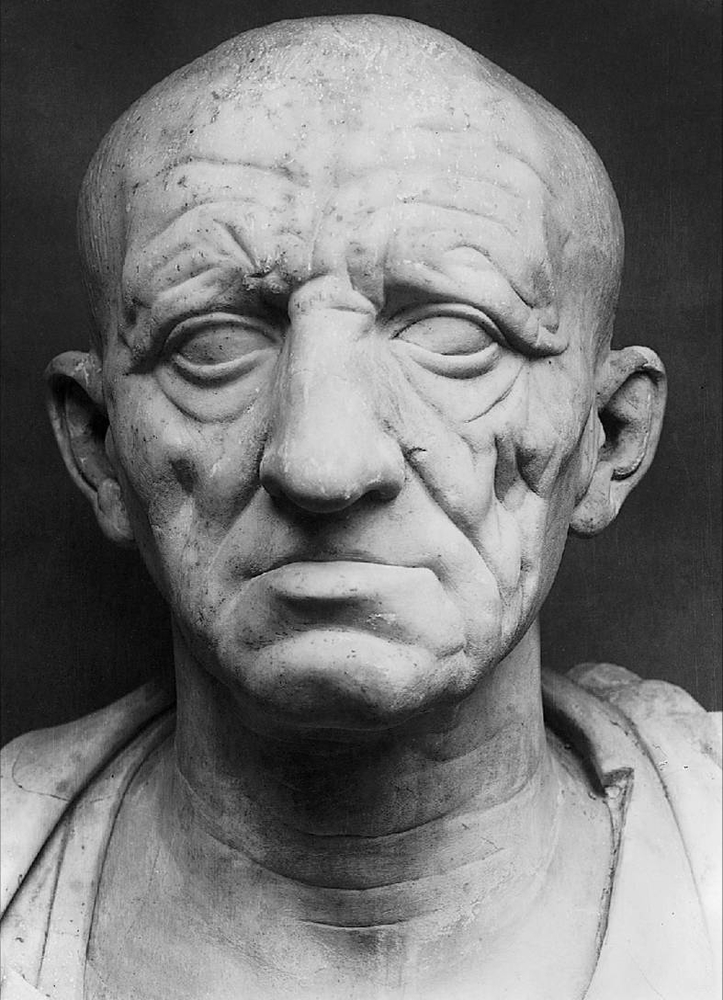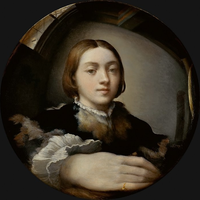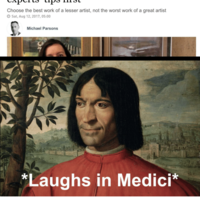More about Perseus with the Head of Medusa
- All
- Info
- Shop

Sr. Contributor
Cellini gives us yet another example proving that depictions of unattainable beauty standards for snake-haired demigods permeate our society.
Cosimo Medici commissioned this 18-foot giant from Cellini to show the people of Florence what sort of de facto ruler they could expect. (Spoiler alert: a selfish, tyrannical one.) And, as such, Perseus is Cosimo and Medusa's decapitated head and headless corpse are the people of Florence...if they don't watch it. Medici figured Cellini's Perseus could be a trilogy with Donatello's Judith and Holofernes and Michelangelo's David to justify de-democratizing the republic. The same principle applies to FOX News, where flashy graphics and pretty people trump facts every time.
Did you notice how Perseus and Medusa are twinsies? In a way, Perseus and Medusa looking alike is a spoiler for the end of the myth. Perseus has lobbed off Medusa's head and will use it to kill the sea monster Cetus and save Andromeda, whom he totally wants to bang. So, in a way, Perseus and Medusa have become the same. Perseus has killed the beast to become the beast. We become the monsters we slay. Well, gee, that makes democracy seems kind of redundant anyway. Party on, Cosimo. You win this round of Propaganda!
Cellini nearly died on this project. He was less comfortable with bronze than gold and, long story short, the roof of his studio caught fire. So much wind and rain rushed through the place that he caught a nasty cold. Working through the sickness, he collapsed and nearly died. As if that weren't enough, the furnace burnt up all the base alloy for the casting, which is kind of like if you were boiling pasta and ran out of water. So Cellini had his servants throw in all the pewter dishware he owned to correct the issue.
This statue is full of Easter eggs. The model for Medusa is one of Cellini's many lovers. To be fair, the guy got around. It was probably more difficult to find a model he hadn't slept with. The back of Perseus' headgear and his well-conditioned locks look like a guy with a sweet beard. Cellini copied how Michelangelo wrote his signature on the St. Peter's Pieta, placing it on the strap across Perseus' rippling pecs. Dude's all core. Goat heads across the top of the pedestal are a nod to Cosimo being a Capricorn. The primo Medici also used Capricorn as a title, a moniker traditionally used by other such level-headed and peaceful folks as Alexander the Great and Emperor Augustus.

Contributor
Perseus (standing heroically with sword and fine abs) and Medusa (the disembodied head and the headless corpse) could not be more different:
1) Boy vs. girl
2) Adventurer vs. priestess turned monster
3) Mycenae vs. Athens
4) Son of an A list god, Zeus, vs. daughter of a B list god, Phorcys
...So why do they look identical?
Featured Content
Here is what Wikipedia says about Perseus with the Head of Medusa


Perseus with the Head of Medusa is a bronze sculpture made by Benvenuto Cellini in the period 1545–1554. The sculpture stands on a square base which has bronze relief panels depicting the story of Perseus and Andromeda, similar to a predella on an altarpiece. It is located in the Loggia dei Lanzi in the Piazza della Signoria in Florence, Italy. The second Florentine duke, Cosimo I de' Medici, commissioned the work with specific political connections to the other sculptural works in the piazza. When the piece was revealed to the public on 27 April 1554, Michelangelo's David, Bandinelli's Hercules and Cacus, and Donatello's Judith and Holofernes were already installed in the piazza.
The subject matter of the work is the mythological story of Perseus beheading Medusa, a hideous woman-faced Gorgon whose hair had been turned to snakes; anyone who looked at her was turned to stone. Perseus stands naked except for a sash and winged sandals, triumphant on top of the body of Medusa with her head, crowned with writhing snakes, in his raised hand. Blood spews from Medusa's severed neck. The bronze sculpture, in which Medusa's head turns men to stone, is appropriately surrounded by three huge marble statues of men: Hercules, David, and later Neptune. Cellini's use of bronze in Perseus and the head of Medusa, and the motifs he used to respond to the previous sculpture in the piazza, were highly innovative. Examining the sculpture from the back, one can see a self-portrait of the sculptor Cellini on the back of Perseus's helmet.
Check out the full Wikipedia article about Perseus with the Head of Medusa
















